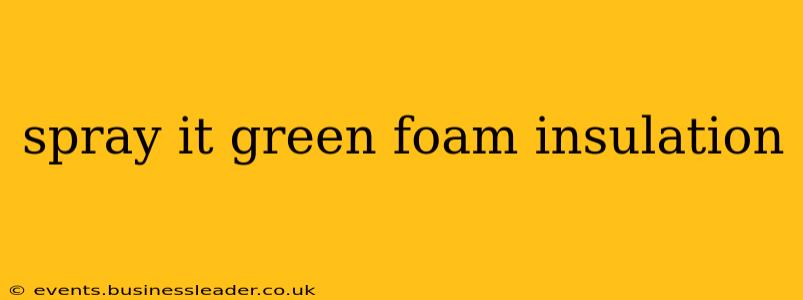Spray foam insulation has become increasingly popular for its superior energy efficiency and air sealing capabilities. But with growing environmental awareness, many homeowners are asking: Is spray foam insulation truly "green"? The answer, as with most things, is nuanced. Let's delve into the world of eco-friendly spray foam insulation, exploring its benefits, drawbacks, and how to make the most environmentally conscious choice.
What is Spray Foam Insulation?
Spray foam insulation is a two-part liquid mixture that expands and hardens upon application, creating a seamless, air-tight barrier. This airtight seal significantly reduces air infiltration, a major source of energy loss in buildings. There are two main types: open-cell and closed-cell. Open-cell spray foam is less dense, more permeable to water vapor, and generally less expensive. Closed-cell spray foam is denser, more water-resistant, and provides higher R-value (insulating power) per inch. The choice between them often depends on the specific application and climate.
Is Spray Foam Insulation Environmentally Friendly?
This is a key question, and the answer depends on several factors, primarily the type of foam and its chemical composition. Some spray foams contain harmful volatile organic compounds (VOCs), which can contribute to air pollution and have negative health impacts. However, low-VOC or zero-VOC spray foam options are increasingly available, offering a more environmentally friendly alternative.
What are the Environmental Impacts of Spray Foam Insulation?
The environmental impact of spray foam insulation hinges on several key factors:
- Manufacturing processes: The energy used to produce the chemicals and the resulting greenhouse gas emissions are crucial considerations.
- Chemical composition: The presence of harmful VOCs, ozone-depleting substances (ODS), and other harmful chemicals significantly impacts the environmental footprint. Look for certifications and labels that verify low or zero VOC content.
- Installation process: Proper installation is critical to minimizing waste and ensuring the long-term effectiveness of the insulation. Improper application can lead to material loss and decreased efficiency.
- Lifecycle impact: The durability and longevity of the insulation will influence its overall environmental impact. A longer-lasting product reduces the need for replacements and associated manufacturing and transportation emissions.
What are the Benefits of Eco-Friendly Spray Foam Insulation?
Despite the potential environmental concerns, choosing eco-friendly spray foam insulation offers several significant advantages:
- Superior energy efficiency: This leads to reduced energy consumption and lower utility bills, thereby reducing your carbon footprint.
- Improved indoor air quality: Low-VOC spray foams minimize the release of harmful chemicals into your living space.
- Reduced noise pollution: The dense nature of spray foam provides excellent sound insulation.
- Pest control: The air-tight seal helps prevent pests from entering your home.
- Moisture control (closed-cell): Closed-cell foam's water-resistant properties prevent moisture damage.
What are the different types of eco-friendly spray foam insulation?
Several manufacturers produce spray foam insulation with a focus on reducing environmental impact. These often utilize bio-based materials or incorporate recycled content in their formulations. Always check the product specifications and look for certifications like GreenGuard Gold or similar eco-labels that verify the low-VOC or zero-VOC claim.
How much does eco-friendly spray foam insulation cost?
The cost of eco-friendly spray foam insulation varies depending on several factors, including the type of foam, the size of the area being insulated, and the contractor's labor rates. While it may be slightly more expensive than conventional spray foam, the long-term energy savings can offset the initial investment.
Is spray foam insulation safe for health?
Choosing low-VOC or zero-VOC spray foam significantly reduces potential health risks associated with exposure to harmful chemicals. However, it is always best to ensure proper ventilation during and after the installation process. Follow the manufacturer's safety recommendations and consult with your installer regarding any potential health concerns.
How long does spray foam insulation last?
Properly installed spray foam insulation can last for decades, providing long-term energy savings and minimizing the need for future replacements.
Conclusion: Making the Green Choice
While not all spray foam insulation is created equal, opting for low-VOC or zero-VOC options allows homeowners to enjoy the benefits of superior insulation while minimizing their environmental impact. By carefully researching available products and choosing a reputable installer, you can make an informed decision that benefits both your home and the planet. Remember to always prioritize certified, low-VOC products and ensure proper installation for optimal results.
